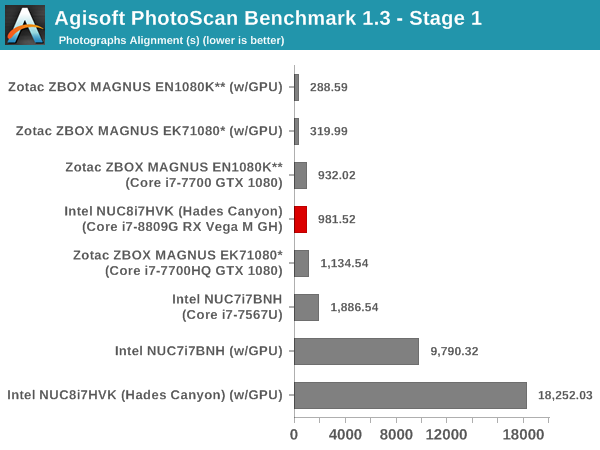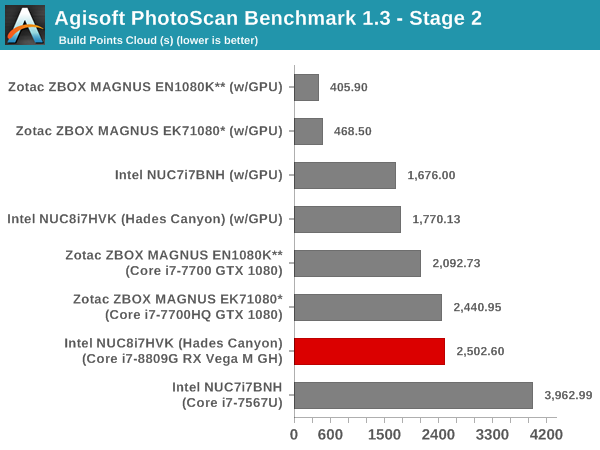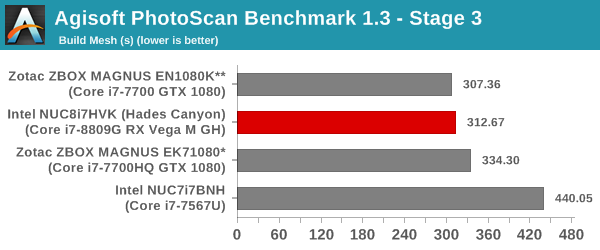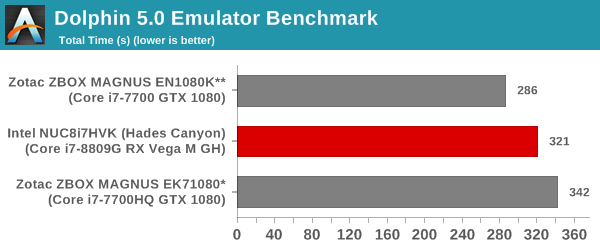The Intel NUC8i7HVK (Hades Canyon) Review: Kaby Lake-G Benchmarked
by Ganesh T S on March 29, 2018 1:00 PM ESTPerformance Metrics - II
In this section, we mainly look at benchmark modes in programs used on a day-to-day basis, i.e, application performance and not synthetic workloads.
x264 Benchmark
First off, we have some video encoding benchmarks courtesy of x264 HD Benchmark v5.0. This is simply a test of CPU performance. As expected, the Core i7-8809G with its 65W processor TDP slots closer to the Core i7-6700 and the Core i7-7700. Recent releases of the x264 benchmark can show even more impressive gains, as they make use of the latest and greatest features of the modern Intel processors.


7-Zip
7-Zip is a very effective and efficient compression program, often beating out OpenCL accelerated commercial programs in benchmarks even while using just the CPU power. 7-Zip has a benchmarking program that provides tons of details regarding the underlying CPU's efficiency. In this subsection, we are interested in the compression and decompression MIPS ratings when utilizing all the available threads. The performance order is similar to the one encountered in the x264 benchmark.


TrueCrypt
As businesses (and even home consumers) become more security conscious, the importance of encryption can't be overstated. CPUs supporting the AES-NI instruction for accelerating the encryption and decryption processes have become more widespread over the last few years. TrueCrypt, a popular open-source disk encryption program can take advantage of the AES-NI capabilities. The TrueCrypt internal benchmark provides some interesting cryptography-related numbers to ponder. In the graph below, we can get an idea of how fast a TrueCrypt volume would behave in the Intel NUC8i7HVK (Hades Canyon) and how it would compare with other select PCs. This is a purely CPU feature / clock speed based test.

Agisoft Photoscan
Agisoft PhotoScan is a commercial program that converts 2D images into 3D point maps, meshes and textures. The program designers sent us a command line version in order to evaluate the efficiency of various systems that go under our review scanner. The command line version has two benchmark modes, one using the CPU and the other using both the CPU and GPU (via OpenCL). We have been using an old version of the program with 50 photogaphs in our reviews till now. The updated benchmark (v1.3) now takes around 84 photographs and does four stages of computation:
- Stage 1: Align Photographs (capable of OpenCL acceleration)
- Stage 2: Build Point Cloud (capable of OpenCL acceleration)
- Stage 3: Build Mesh
- Stage 4: Build Textures
We record the time taken for each stage. Since various elements of the software are single threaded, others multithreaded, and some use GPUs, it is interesting to record the effects of CPU generations, speeds, number of cores, DRAM parameters and the GPU using this software.
The GPU-enabled numbers for Stage 1 and 2 below are with the use of the Intel HD Graphics 630, since our benchmark version only supports use of the first enumerated GPU. Unfortunately, when we tried to disable the integrated GPU and use only the discrete GPU after changing the BIOS setting, the benchmark consistently crashed while starting the first stage itself.




Dolphin Emulator
Wrapping up our application benchmark numbers is the new Dolphin Emulator (v5) benchmark mode results. This is again a test of the CPU capabilities, and the Core i7-8809G slots inbetween the 45W TDP Core i7-7700HQ and the 65W Core i7-7700.











124 Comments
View All Comments
Samus - Saturday, March 31, 2018 - link
Seriously, this is essentially an iGPU. 4K? Be reasonable. It’s actually quite amazing how powerful this is to be able to match a GTX 970 at 1080p and surpass a 980 at lower resolutions.Can’t wait to see these in light gaming notebooks. No reason you couldn’t power the system with a 130w PSU, meaning USB-C powered.
nathanddrews - Monday, April 2, 2018 - link
I had to re-re-read the graphs to comprehend that this IGP is faster than my 3570K/GTX 970 setup. You pay for it, though...WinterCharm - Monday, April 2, 2018 - link
To be fair, this is not a traditional IGP. This is a Radeon Vega chip with 24 CUs, 1536 shader units, and 64 ROP's connected to 4GB of HBM2. It's attached to the Intel CPU via 8 PCIE lanes over an interposer, and is two chips + HBM assembled into one unit.Fallen Kell - Friday, April 6, 2018 - link
Except you are simply much better off just getting an Xbox One X or PS4 Pro at half the price...iter - Thursday, March 29, 2018 - link
Hey, at least it unlocks performance with a locked CPU ;)Crazyeyeskillah - Thursday, March 29, 2018 - link
This is barely passable at 1080p. For older titles in early dx11 and lower it will be fine, but this isn't a modern gaming box by any stretch of the imagination. I bet it would be close to on par with an original ps4 performance.Drumsticks - Thursday, March 29, 2018 - link
That's pretty objectively false. In most benchmarks, it is, as the review mentions, slotting between a GTX 960 and GTX 980. Realistically, it's somewhere in the realm of a GTX 970 or a bit less which puts it, again, in the realm of the GTX 1050 Ti to RX 470. Both of those would be significantly more powerful than the PS4 Original.Even from a mathematical perspective, 24CUs at up to 1190 MHz vs 18 CUs at 800MHz is pretty self explanatory.
Cooe - Friday, March 30, 2018 - link
Are you kidding? This obliterates a base model PS4. It falls behind a GTX 1060 Max Q.Samus - Saturday, March 31, 2018 - link
Last I checked the PS4 non-Pro has a GPU on par with a 750Ti. This thing is on par with a GTX970. That’s twice as powerful as a 750Ti.HStewart - Friday, March 30, 2018 - link
Keep in mind - in truth the Kaby Lake G is actually intended for a mobile CPU - in that arena - it very good. Especially that it also intended to be in ultra portable market.